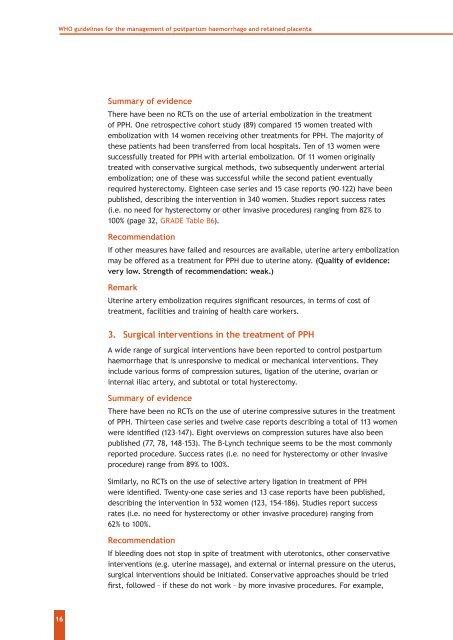WHO guidelines for the management of postpartum haemorrhage ...
WHO guidelines for the management of postpartum haemorrhage ...
WHO guidelines for the management of postpartum haemorrhage ...
Create successful ePaper yourself
Turn your PDF publications into a flip-book with our unique Google optimized e-Paper software.
<strong>WHO</strong> <strong>guidelines</strong> <strong>for</strong> <strong>the</strong> <strong>management</strong> <strong>of</strong> <strong>postpartum</strong> <strong>haemorrhage</strong> and retained placenta<br />
Summary <strong>of</strong> evidence<br />
There have been no RCTs on <strong>the</strong> use <strong>of</strong> arterial embolization in <strong>the</strong> treatment<br />
<strong>of</strong> PPH. One retrospective cohort study (89) compared 15 women treated with<br />
embolization with 14 women receiving o<strong>the</strong>r treatments <strong>for</strong> PPH. The majority <strong>of</strong><br />
<strong>the</strong>se patients had been transferred from local hospitals. Ten <strong>of</strong> 13 women were<br />
successfully treated <strong>for</strong> PPH with arterial embolization. Of 11 women originally<br />
treated with conservative surgical methods, two subsequently underwent arterial<br />
embolization; one <strong>of</strong> <strong>the</strong>se was successful while <strong>the</strong> second patient eventually<br />
required hysterectomy. Eighteen case series and 15 case reports (90–122) have been<br />
published, describing <strong>the</strong> intervention in 340 women. Studies report success rates<br />
(i.e. no need <strong>for</strong> hysterectomy or o<strong>the</strong>r invasive procedures) ranging from 82% to<br />
100% (page 32, GRADE Table B6).<br />
Recommendation<br />
If o<strong>the</strong>r measures have failed and resources are available, uterine artery embolization<br />
may be <strong>of</strong>fered as a treatment <strong>for</strong> PPH due to uterine atony. (Quality <strong>of</strong> evidence:<br />
very low. Strength <strong>of</strong> recommendation: weak.)<br />
Remark<br />
Uterine artery embolization requires significant resources, in terms <strong>of</strong> cost <strong>of</strong><br />
treatment, facilities and training <strong>of</strong> health care workers.<br />
3. Surgical interventions in <strong>the</strong> treatment <strong>of</strong> PPH<br />
A wide range <strong>of</strong> surgical interventions have been reported to control <strong>postpartum</strong><br />
<strong>haemorrhage</strong> that is unresponsive to medical or mechanical interventions. They<br />
include various <strong>for</strong>ms <strong>of</strong> compression sutures, ligation <strong>of</strong> <strong>the</strong> uterine, ovarian or<br />
internal iliac artery, and subtotal or total hysterectomy.<br />
Summary <strong>of</strong> evidence<br />
There have been no RCTs on <strong>the</strong> use <strong>of</strong> uterine compressive sutures in <strong>the</strong> treatment<br />
<strong>of</strong> PPH. Thirteen case series and twelve case reports describing a total <strong>of</strong> 113 women<br />
were identified (123–147). Eight overviews on compression sutures have also been<br />
published (77, 78, 148–153). The B-Lynch technique seems to be <strong>the</strong> most commonly<br />
reported procedure. Success rates (i.e. no need <strong>for</strong> hysterectomy or o<strong>the</strong>r invasive<br />
procedure) range from 89% to 100%.<br />
Similarly, no RCTs on <strong>the</strong> use <strong>of</strong> selective artery ligation in treatment <strong>of</strong> PPH<br />
were identified. Twenty-one case series and 13 case reports have been published,<br />
describing <strong>the</strong> intervention in 532 women (123, 154–186). Studies report success<br />
rates (i.e. no need <strong>for</strong> hysterectomy or o<strong>the</strong>r invasive procedure) ranging from<br />
62% to 100%.<br />
Recommendation<br />
If bleeding does not stop in spite <strong>of</strong> treatment with uterotonics, o<strong>the</strong>r conservative<br />
interventions (e.g. uterine massage), and external or internal pressure on <strong>the</strong> uterus,<br />
surgical interventions should be initiated. Conservative approaches should be tried<br />
first, followed – if <strong>the</strong>se do not work – by more invasive procedures. For example,<br />
16
















